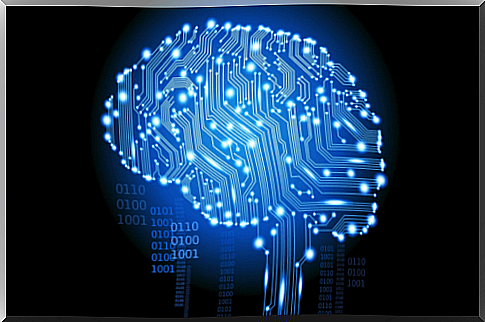Do You Know What Computational Thinking Is?

Computational thinking is a skill that can open many doors in the future. Knowing how to formulate problems, organize information logically, or think abstractly are basic processes that formulate this valuable cognitive approach.
In an increasingly complex world, we undoubtedly need to know how to tackle the challenges of our environment. So does this approach mean learning to think like machines do? No not really. It also integrates many of the areas that artificial intelligence cannot currently handle or reach.
Lateral thinking is also related to computational reasoning, as is knowing how to deal with emotional variables and especially understanding human behavior.
Of course, the term “computational” automatically reminds us of the world of logarithms, chips and subroutines of advanced computers. What this approach refers to, however, is something quite different.
Indeed, this perspective aims to tackle all the problems that will arise in the coming years by reconciling technology and humanity, needs with answers and challenges with innovative proposals. So let’s take a closer look at this topic.

Computational Thinking: Definition, Characteristics and Purpose
Computational thinking is a term that originates from the theories of Seymour Papert, pioneer of artificial intelligence and inventor of the Logo programming language in 1968.
In 1995 he also identified the need to reformulate the education system and integrate computers and their language into the school curriculum. Thus, he foresaw the need to provide the world with people trained in computers.
dr. Papert laid the foundations of this approach during the 1990s. After his death, Dr. Jeannette Wing, however, further developed this idea.
This computer engineer and former vice president of Microsoft explained in her research work that computational thinking will affect all fields of work. One of her most important articles was ‘Computational thinking and thinking about computers’ .
She also emphasizes the importance of what Papert proposed: that this new competence should be integrated into the school curriculum. It is an essential skill that will support in so many fields in the future, such as engineering, humanities and natural sciences. So let’s take a look at what computational thinking consists of.
What is it exactly?
Computational thinking is a high-level cognitive process that allows us to think scientifically when solving problems. One thing we know is that computers and new technologies make our lives easier by solving multiple challenges. However, we have to be one step ahead of them.
Furthermore, Dr. Jeannette Win insists that we need to understand how machines ‘think’ in order to improve their operation in the future. What we need is to know how to combine natural processes with artificial ones.
We must therefore learn how to combine our intuition and lateral thinking with the cognitive processes that we extract from the computer.
The Characteristics of Computational Thinking
This type of perspective consists of developing a set of executive functions. In reality, we already use them in our daily lives, but we are not aware of them and we do not get everything out of them that we should.
After all, nothing is as enriching as ‘learning to think better’. This would allow us to solve everyday challenges in a more innovative way.
Computationally, it is based on four basic axes, namely:
- fragment. We can divide any task or problem into smaller parts to better understand them.
- Know how to recognize patterns. Every phenomenon, experience, stimulus, problem or circumstance usually follows an internal scheme and then responds to a pattern that we can identify.
- Abstract thinking. This type of reasoning is exclusive to humans. This type of thinking allows us to create original ideas or even anticipate situations or scenarios to know how we would act in those circumstances.
- algorithms. An algorithm is a plan, series of steps, or diagram that allows us to solve a problem step by step. Algorithms allow us to work out a set of clear and simple instructions to cope with any event. They are defined by a number of aspects. For example, they always have a finite number of steps, they have a specific goal in mind, and are specific (not ambiguous).
The steps
When we use computational thinking, in addition to being aware of all the factors and variables that define it and that we have already analyzed, there is another aspect that we need to understand. It is important to know what order this way of thinking usually follows.
- Analysis. When solving a problem, you should always analyze the problem thoroughly beforehand.
- Abstraction. The second step is to know how to formulate the problem. What is actually happening? Is there a pattern? What strategy can I design? What comes to your mind from past experiences regarding the same situation?
- Wording of the solution or proposal. After you’ve mentally mapped out the strategy to follow, it’s time to apply and test it.
- Evaluation. After implementation, it is time to evaluate. Did I get the desired result or can I improve it in any way?
- Generalize and transfer. When evaluating the success of what you have achieved, you can use what you have developed to apply it in other areas as well.

The importance of learning to think
Daniel Kahneman, psychologist and Nobel laureate, is one of the most important thinkers in the world. He points out that many people today make decisions without reasoning. Instead, they decide to use their impulses. Other people start voting without even knowing what or who they are voting for.
Nothing can be more decisive and useful than teaching new generations to think. We need to help people to look at things critically or to know how to observe reality from a more analytical and reflective perspective.
Computational thinking is the driving force for the future. Not only does it help us solve problems more intelligently, but it also allows us to stay one step ahead of artificial intelligence. This is important so that the world of technology is always at the service of humanity. Let’s keep this in mind.









